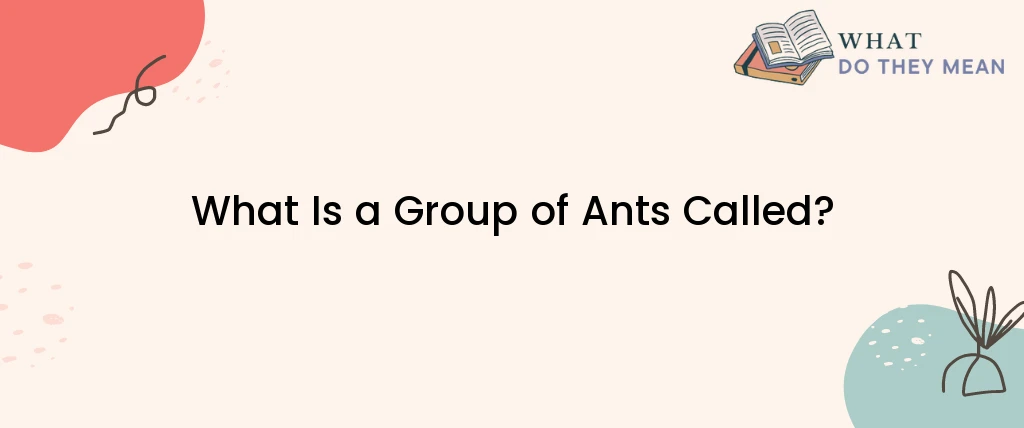Ants, the tiny creatures that crawl on the ground with remarkable efficiency and coordination, have long captured the curiosity of scientists and nature enthusiasts alike. While observing these fascinating insects, you might have wondered, “What is a group of ants called?” This article will delve into the intricate world of ants, exploring their social structure and behavior and ultimately uncovering the answer to this intriguing question.
Ants, belonging to the family Formicidae, are highly social insects that exhibit fascinating behaviors and organizational skills. They live in large colonies with complex social structures, where individual ants work together for the group’s greater good.
The Social Structure of Ant Colonies
Ant colonies have various castes, each with specific roles and responsibilities. The three primary castes found in most ant species are queens, males, and workers. The queen’s primary function is reproduction, while the male aims to mate with the queen. The workers comprise most of the colony and are responsible for various tasks such as foraging, nest maintenance, and caring for the young.
The Roles Within an Ant Colony
Within the worker caste, ants perform specific roles depending on their age and abilities. Young workers typically engage in tasks inside the nest, such as caring for the brood and maintaining the nest’s cleanliness. As they mature, they take on more complex roles, such as foraging, defending the colony, and even participating in construction activities.
You may also like: What is a Group of Mice Called?
How Ants Communicate
Ants have developed intricate communication systems to coordinate their activities within the colony. They use a combination of chemical signals (pheromones), tactile cues, and even auditory signals to convey information to other colony members. Through these communication channels, ants can alert their fellow workers about food sources, danger, and the presence of intruders.
Foraging and Nesting Behavior
Ants display remarkable foraging behavior, scouring their surroundings in search of food. They leave pheromone trails as they travel, allowing other ants from the colony to follow the trail and find the food source. Ants also exhibit diverse nesting behaviors, with some species creating elaborate underground chambers while others build nests in trees or other natural structures.
Defense Mechanisms of Ants
To protect their colonies, ants have evolved an array of defense mechanisms. Some ant species have powerful jaws or stingers to ward off potential threats. Additionally, certain ants can release chemical compounds as a defense, repelling or even incapacitating their enemies.
Ants’ Impact on Ecosystems
Ants play significant roles in ecosystems, contributing to seed dispersal, soil aeration, and nutrient recycling. They also act as predators, controlling populations of other insects and playing a vital role in maintaining ecological balance. However, some ant species can become invasive and disrupt native ecosystems, highlighting the delicate balance between the benefits and challenges associated with ants.
Fun Facts About Ants
- Ants can carry objects that weigh up to 50 times their body weight.
- Some ants cultivate fungus gardens and feed on the fungi they cultivate.
- Certain ant species engage in agriculture by farming aphids for their honeydew.
- Army ants, known for their aggressive behavior, form temporary nests by linking their bodies.
- Leafcutter ants have a fascinating symbiotic relationship with certain fungi, using them to break down the leaves they collect for food.
FAQs
A group of ants is commonly referred to as a colony.
The size of an ant colony can vary greatly depending on the species. It can range from a few hundred to millions of ants.
Conclusion
In conclusion, ants are remarkable creatures that thrive in highly organized societies. Understanding the intricacies of their social structure, communication methods, and behaviors allows us to appreciate their significance in ecosystems. So, the next time you encounter a group of ants diligently working together, remember that they are part of a complex and interconnected world.

As a researcher, I am curious and driven by the pursuit of knowledge. I approach my work with a critical eye, carefully evaluating sources and methods to ensure that my findings are accurate and reliable. Whether delving into scientific studies, historical records, or cutting-edge technologies, I am always seeking to expand my understanding and make new discoveries. I am dedicated to uncovering new insights and finding solutions to complex problems, and am driven by a passion for uncovering the truth.

